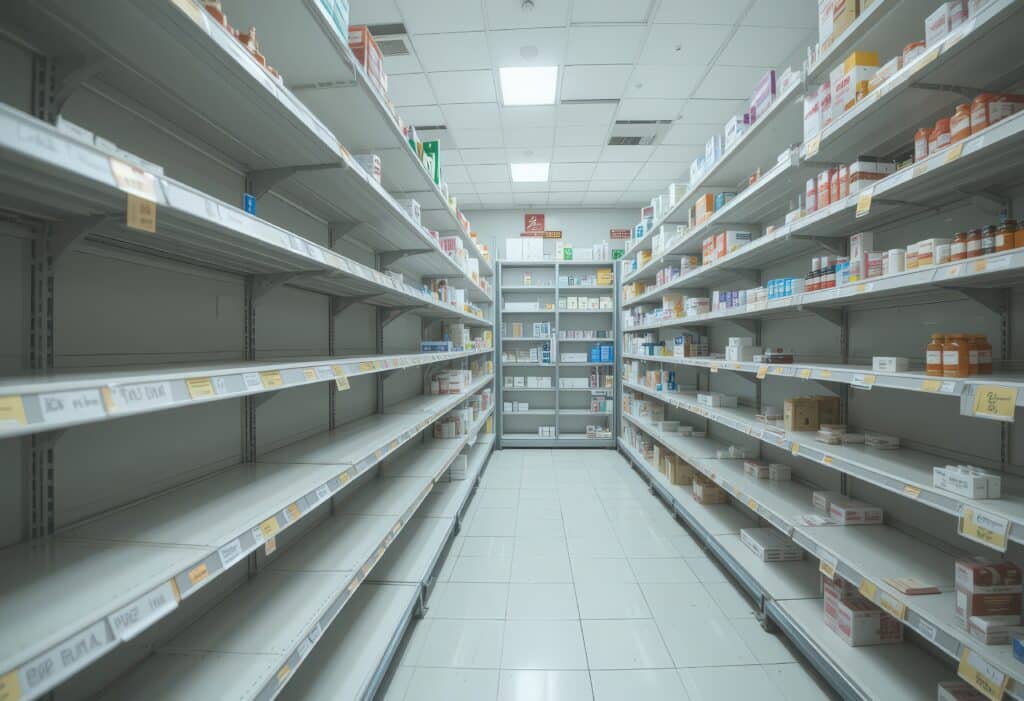Drug shortages: 39% of French people at risk in 2024
- In 2024, 39% of French people said they experienced medicines shortages, and 35% of them said that no alternative treatments were made available.
- The daily number of medicines of therapeutic importance in short supply peaked during the first lockdown, reaching a very high level during the winter of 2022-2023.
- A stock shortage reported by a laboratory leads to an average 11% drop in deliveries to pharmacies throughout the duration of a shortage.
- Between the end of 2022 and the end of 2024, laboratories built up an average of three weeks’ worth of stock for products reported as at risk of shortage, but this suggests that the risks are becoming more complex.
- While it is difficult to identify the causes of the medicine crisis, increased demand and the Covid pandemic may have affected the market.
39% of French people say they experienced medicines shortages in 20241 – up from 44% in 2023 – and 35% of them say they were unable to obtain alternative treatments. To quantify the extent of the shortage in France, the DREES (Direction de la recherche, des études, de l’évaluation et des statistique) conducted an original study at the request of the ANSM (Agence nationale de sécurité du médicament et des produits de santé) using data from laboratories and wholesalers/distributors. Clément Dherbécourt, an expert in public policy evaluation at the DREES and co-author of the study, details the main findings.
What were the objectives of this study?
Clément Dherbécourt. We had two main objectives: the first was to improve the accuracy of the tension signal on drug production by producing daily analyses of the number of stockouts and stockout risks within laboratories, as well as the sales volumes to pharmacies affected by these tensions. The second objective was to estimate the change in the number of “missing boxes”, i.e. boxes that could not be sold to pharmacies by their suppliers, which is currently the most relevant indicator of the shortage situation.
To do this, we relied on two main data sets. DREES had figures for sales of medicines to pharmacies, either by wholesalers-distributors (who account for 80% of the volume of boxes sold) or directly by laboratories. ANSM gave us access to the reports of shortages and risks of shortages submitted by laboratories.
Is there no publicly available data that can be used to directly measure unmet demand for medicines in pharmacies?
Not at present. To get a better idea of this figure, we would need to rely on an electronic prescription system, which is only just beginning to be developed. Alternatively, we could consider more indirect data, such as figures on orders placed by pharmacies for individual medicines. This data exists but is not currently publicly available. The 2025 Social Security Financing Act2, which has been passed but has not yet come into force, creates a public system for accessing pharmacy order data to enable more detailed analysis by the authorities.
Based on your findings, how have medicines shortages evolved over the last few years?
We looked at medicines of major therapeutic interest (MMTI) for which the ANSM drew up the first official list at the end of 2024, covering around 10,000 products (editor’s note: the same molecule can give rise to several products if there are several dosages or manufacturers) out of the 17,000 marketed.

From mid-2016 to 2017, the daily number of MMTIs in short supply remained relatively stable, at around 100 drugs. It began to rise at the end of 2017, peaking at around 250 during the first lockdown in 2020. From 2021 onwards, the upward trend accelerated, with a very clear peak emerging in the winter of 2022–2023, reaching 800 MMTI shortages per day. Since then, there has been a slow decline to 400 by the end of 2024. However, this level remains very high compared to pre-Covid levels. The average number of therapeutic alternatives available, without disruption or risk of disruption, was 5 in summer 2021, 4 in January 2022, 1.6 throughout 2023, falling to 2 at the end of 2024.
What is the impact of supply chain disruptions within laboratories on drug sales to pharmacies?
A stock shortage declared by a laboratory, across all drugs, leads to an average 11% drop in deliveries to pharmacies throughout the duration of the disruption. This is significant, of course, but we cannot talk about a widespread collapse.
However, this average masks a wide range of situations. As might be expected, long stock shortages (more than four months) can lead to very significant declines in sales, of more than 75%, over several months. Conversely, shorter shortages of three months have no impact on sales. We can assume that these situations reflect cases where wholesalers still had stocks or where manufacturers produced the medicines in question on a just-in-time basis.
How many “missing boxes” does this drop in sales represent?
In March 2023, at the height of the 2022–2023 winter crisis, shortages led to 8 million fewer boxes being sold in pharmacies. The overall market for the medicines concerned was estimated at 80 million or 120 million boxes per month, depending on whether MMTIs are defined according to the ANSM or according to the definition that has been used by laboratories for several years, which adds several dozen paracetamol-based medicines to the ANSM list. Depending on the definition used, this represents a 10% or 6.5% drop in the number of boxes sold. However, these figures do not consider any increases in the production and sale of alternative treatments, which were not affected by the shortage.
You also looked at the risks of shortages, reported by laboratories as a precautionary measure. How have these evolved since the peak in winter 2022–2023?
Between the end of 2022 and the end of 2024, laboratories built up an average of three weeks’ worth of stock for products reported as at risk of shortage. But despite this positive trend, there are signs that these risks are becoming more complex. The number of drugs subject to ANSM measures (import authorisations, quotas on the number of boxes or patient prioritisation, for example) rose by ten points in 2024.
What light do your findings shed on the causes of the current crisis?
Disruption reports alone are not very informative: when reporting a disruption, laboratories must select a reason for the manufacturing issue they are experiencing from a predefined list, but in most cases, the explanations provided are too general to identify a specific cause: “insufficient production capacity”, “increase in sales volume”, or even “other…
However, when taken together, two factors point to systemic causes: the almost perfect correlation between the change in the number of medicines over time in relation to the inflation curve, and the fact that all categories of medicines have been affected by the increase in the number of shortages, even if they peaked at different times.
What do you mean by systemic causes?
One possibility is the well-documented increase in global demand for drugs, with a particular rise in purchases outside the United States and Europe. The consequences of the Covid crisis and the war in Ukraine have also caused inflation to rise and disrupted production chains worldwide, which may have affected the drug market. Supply chain issues for raw materials, which are sometimes suspected of playing a significant role, do not appear to be among the main causes. In fact, laboratories only reported this type of problem in one in ten cases of shortages.
The price of medicines in France, which is relatively low compared to its European neighbours, has sometimes been presented as one of the main causes of the shortage…
The study does not allow us to settle this debate. It would be necessary to observe the actual price from one country to another, which is not possible at present because the discounts negotiated by individual governments are not known. At this stage, the precise causes of the shortages remain difficult to pinpoint, as they are necessarily multifactorial and vary greatly from one medicine to another. In general, it can be noted that the improvement in the situation since winter 2022–2023 has occurred without any significant change in medicine prices in France. This suggests that stock shortages are not entirely determined by the issue of prices.
Interview by Anne Orliac
https://www.france-assos-sante.org/wp-content/uploads/2025/03/BVA-pour-France-Assos-Sante-Barometre-des-droits-des-personnes-malades-2025-Mars-2025.pdf↑














